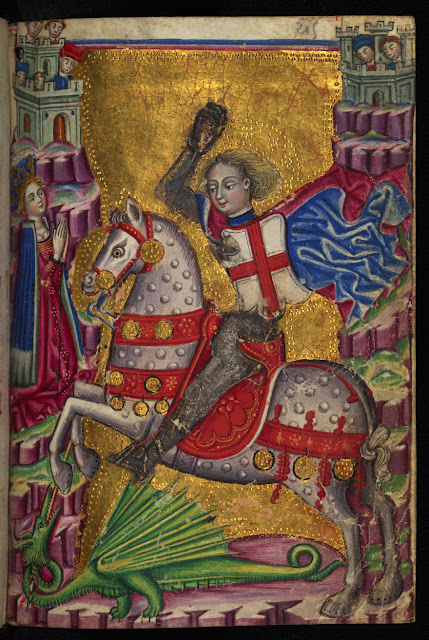Artist unknown
Miracle of St. George about the serpent, Mid 14th century
Novgorod. State Tretyakov Gallery, Moscow
Saint George (circa 275/281 – 23 April 303 AD) was
a soldier in the Roman army who later became venerated as a Christian martyr.
His parents were Christians of Greek background; his father Gerontius was a
Roman army official from Cappadocia and his mother Polychronia was from Lydda,
Syria Palaestina. Saint George became an officer in the Roman army in the Guard
of Diocletian, who ordered his death for failing to recant his Christian faith.
Dante Gabriel Rossetti
The wedding of Saint George and Princess Sabra, c. 1857
Watercolor
34 x 34 cm
Tate Modern, London, UK
Dante Gabriel Rossetti (12 May 1828 – 9 April
1882) was an English poet, illustrator, painter and translator. He
founded the Pre-Raphaelite Brotherhood in 1848 with William Holman Hunt and
John Everett Millais. Rossetti was later to be the main inspiration for a
second generation of artists and writers influenced by the movement. His work
also influenced the European Symbolists and was a major precursor of the
Aesthetic movement.
Rossetti's personal life was closely linked to his work,
especially his relationships with his models and muses Elizabeth Siddal, Fanny
Cornforth and Jane Morris. More on Dante
Gabriel Rossetti
In the fully developed Western version of the Saint George
Legend, a dragon, or crocodile, makes its nest at the spring that provides
water for the city of "Silene" (perhaps modern Cyrene in Libya or the
city of Lydda in Palistine, depending on the source). Consequently, the
citizens have to dislodge the dragon from its nest for a time, to collect
water. To do so, each day they offer the dragon at first a sheep, and if no
sheep can be found, then a maiden is the best substitute for one. The victim is
chosen by drawing lots. One day, this happens to be the princess. The monarch
begs for her life to be spared, but to no avail. She is offered to the dragon,
but then Saint George appears on his travels. He faces the dragon, protects
himself with the sign of the Cross, slays the dragon, and rescues the princess.
The citizens abandon their ancestral paganism and convert to
Christianity. More
on Saint George
Zanino di Pietro (Italian, active from 1389, died before 1448)
Saint George Killing the Dragon
Ink, paint and gold on parchment
4 1/8 x 2 15/16 in. (10.5 x 7.4 cm)
The Walters Art Museum, Baltimore
Sano was born in 1406. His name enters the roll of painters in 1428 where it remained until his death in 1481. In addition to his own painting and overseeing the pupils and assistants in his workshop, Sano was also part of the civic fabric of Siena, in 1431 and 1442 he was the leader of the San Donato district of Siena. Sano was also employed as an arbitrator; in 1475 he was called upon to settle a dispute between fellow painters Neroccio di Bartolommeo and Francesco di Giorgio Martini.
It was, however, as a painter that he made his living. The workshop he ran produced huge number of artworks. He wasn't merely a painter of altar pieces. He also produced frescoes, miniatures, and book bindings. Sano died in 1481. More on Sano di Pietro
Please visit my other blogs: Art
Collector, Mythology, Marine
Art, Portrait of a Lady, The
Orientalist, Art of the Nude and The
Canals of Venice, Middle
East Artists, and 365 Saints, also visit my Boards on Pinterest
Images are copyright of their
respective owners, assignees or others. Some Images may be subject to copyright
I don't own any of these images -
credit is always given when due unless it is unknown to me. if I post your
images without your permission, please tell me.
I do not sell art, art prints, framed
posters or reproductions. Ads are shown only to compensate the hosting
expenses.
If you enjoyed this post, please share
with friends and family.
Thank you for visiting my blog and also
for liking its posts and pages.
Please note that the content of this
post primarily consists of articles available from Wikipedia or other free
sources online.




No comments:
Post a Comment
Note: Only a member of this blog may post a comment.